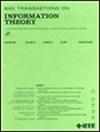排列通道上的识别
IF 2.9
3区 计算机科学
Q3 COMPUTER SCIENCE, INFORMATION SYSTEMS
引用次数: 0
摘要
我们研究了在一个无噪声的q元均匀排列信道上的消息识别,其中传输矢量由随机均匀选择的排列进行排列。该信道是无噪声的,因为该信道仅以不同的顺序重新排列符号,而不改变符号值。对于离散无内存信道(dmc),可识别消息的数量呈指数倍增长。识别能力,即最大二阶指数,已知与DMC的香农能力相同。排列通道只支持多项式多个消息的可靠通信。一个简单的可实现性结果表明,随着$2^{\epsilon _{n}n^{q-1}}$增长的消息大小对于任何$\epsilon _{n}\rightarrow 0$都是可识别的。我们证明了两个相反的结果。“软”反向表明,对于任何$R\gt 0$,都不存在消息大小随着$2^{Rn^{q-1}}$的幂律衰减($n^{-\mu }$)而增长的识别码序列。我们还证明了一个“强”逆,表明对于消息大小为$2^{R_{n} n^{q-1}}$的任何识别码序列,其中$R_{n} \rightarrow \infty $,类型I和类型II错误概率的总和至少接近1为$n\rightarrow \infty $。为了证明软逆性,我们用一系列步骤构造了一个与集合系统相关的结构更简单的新识别码,然后使用了集合系统的归一化最大两两相交的下界。为了证明强逆,我们利用了分布近似的结果。将可得性和逆向结果推广到多块编码的情况。我们还表明,在确定性编码下,每个块可以识别的消息数量是类型的数量,即$\binom {n+q-1}{q-1}$,这与可靠通信的消息大小相同。最后,我们研究了在接收方存在因果块反馈的q-ary均匀排列信道上的消息识别,其中编码器在块传输完成后接收到整个n长度的接收块。我们证明了在反馈存在的情况下,即使在确定性编码下,可识别消息的最大数量也呈双指数增长,并提出了一个两阶段可实现方案。本文章由计算机程序翻译,如有差异,请以英文原文为准。
Identification Over Permutation Channels
We study message identification over a noiseless q-ary uniform permutation channel, where the transmitted vector is permuted by a permutation chosen uniformly at random. The channel is noiseless in the sense that the channel only rearranges the symbols in a different order, without changing the symbol values. For discrete memoryless channels (DMCs), the number of identifiable messages grows doubly exponentially. Identification capacity, the maximum second-order exponent, is known to be the same as the Shannon capacity of the DMC. Permutation channels support reliable communication of only polynomially many messages. A simple achievability result shows that message sizes growing as $2^{\epsilon _{n}n^{q-1}}$ are identifiable for any $\epsilon _{n}\rightarrow 0$ . We prove two converse results. A “soft” converse shows that for any $R\gt 0$ , there is no sequence of identification codes with message size growing as $2^{Rn^{q-1}}$ with a power-law decay ( $n^{-\mu }$ ) of the error probability. We also prove a “strong” converse showing that for any sequence of identification codes with message size $2^{R_{n} n^{q-1}}$ , where $R_{n} \rightarrow \infty $ , the sum of Type I and Type II error probabilities approaches at least 1 as $n\rightarrow \infty $ . To prove the soft converse, we use a sequence of steps to construct a new identification code with a simpler structure which relates to a set system, and then use a lower bound on the normalized maximum pairwise intersection of a set system. To prove the strong converse, we use results on approximation of distributions. The achievability and converse results are generalized to the case of coding over multiple blocks. We also show that under deterministic encoding, the number of messages that can be identified per block is the number of types, i.e., $\binom {n+q-1}{q-1}$ , and this is same as the message size for reliable communication. We finally study message identification over a q-ary uniform permutation channel in the presence of causal block-wise feedback from the receiver, where the encoder receives an entire n-length received block after the transmission of the block is complete. We show that in the presence of feedback, the maximum number of identifiable messages grows doubly exponentially even under deterministic encoding, and we present a two-phase achievability scheme.
求助全文
通过发布文献求助,成功后即可免费获取论文全文。
去求助
来源期刊

IEEE Transactions on Information Theory
工程技术-工程:电子与电气
CiteScore
5.70
自引率
20.00%
发文量
514
审稿时长
12 months
期刊介绍:
The IEEE Transactions on Information Theory is a journal that publishes theoretical and experimental papers concerned with the transmission, processing, and utilization of information. The boundaries of acceptable subject matter are intentionally not sharply delimited. Rather, it is hoped that as the focus of research activity changes, a flexible policy will permit this Transactions to follow suit. Current appropriate topics are best reflected by recent Tables of Contents; they are summarized in the titles of editorial areas that appear on the inside front cover.
 求助内容:
求助内容: 应助结果提醒方式:
应助结果提醒方式:


